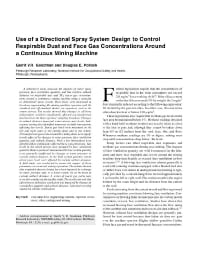Mining Publication: Use of a Directional Spray System Design to Control Respirable Dust and Face Gas Concentrations Around a Continuous Mining Machine
Original creation date: December 2004
Authors: GV Goodman, DE Pollock
NIOSHTIC2 Number: 20025738
J Occup Environ Hyg 2004 Dec 1(12):806-815
A laboratory study assessed the impacts of water spray pressure, face ventilation quantity, and line brattice setback distance on respirable dust and SF6 tracer gas concentrations around a continuous mining machine using a sprayfan or directional spray system. Dust levels were measured at locations representing the mining machine operator and the standard and off-standard shuttle car operators, and in the return airway. The results showed that changes in all three independent variables significantly affected log-transformed dust levels at the three operator sampling locations. Changes in setback distance impacted return airway dust levels. Laboratory testing also identified numerous variable interactions affecting dust levels. Tracer gas levels were measured on the left and right sides of the cutting drum and in the return. Untransformed gas levels around the cutting drum were significantly affected by changes in water pressure, face ventilation quantity, and setback distance. Only a few interactions were identified that significantly affected these concentrations. Gas levels in the return airway were grouped by face ventilation quantity. Return gas levels measured at the low curtain quantity were generally unaffected by changes in water pressure or curtain setback distance. At the high curtain quantity, return airway gas levels were affected by curtain setback distance. A field study was conducted to assess the impact of these parameters in an actual mining operation. These data showed that respirable dust levels may have been impacted by a change in water pressure and, to a lesser extent, by an increase in curtain setback distance. A series of tracer gas pulse tests were also conducted during this study. The results showed that effectiveness of the face ventilation was impacted by changes in curtain flow quantity and setback distance. Laboratory testing supported similar conclusions.

NIOSHTIC2 Number: 20025738
J Occup Environ Hyg 2004 Dec 1(12):806-815
- Continuous Miner Spray Considerations for Optimizing Scrubber Performance in Exhaust Ventilation Systems
- Determining the Spatial Variability of Personal Sampler Inlet Locations
- The Effects of Water Spray Placement for Controlling Respirable Dust and Face Methane Concentrations
- Engineering Considerations and Selection Criteria for Proximity Warning Systems for Mining Operations
- Evaluation of the Wet Head Continuous Miner to Reduce Respirable Dust
- Guidelines for the Control and Monitoring of Methane Gas on Continuous Mining Operations
- Reservoir Engineering Considerations for Coal Seam Degasification and Methane Control in Underground Mines
- A Review of Occupational Silica Exposures on Continuous Mining Operations
- Status of a Tapered Element, Oscillation Microbalance-Based Continuous Respirable Coal Mine Dust Monitor
- Technology News 439 - Remote Reset Systems for Continuous Mining Machines Used In Extended Cuts